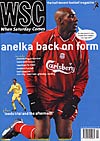 Did football really have a golden age? A new photo collection seems unsure when it was, says Doug Cheeseman, though it definitely took place in London
Did football really have a golden age? A new photo collection seems unsure when it was, says Doug Cheeseman, though it definitely took place in London
This is a giant airbrick of a football photobook, comprised of black and white documentary pictures from the start of the 20th century to 1985. The notional theme of the book is football in its broader social context, in the period before commercialism took over and photographers swapped their black and white films for colour. In other words, football in all its sepia, if sometimes rose-tinted, glory.
The editor, John Tennant, thankfully declares his intent to avoid pictures of obvious goals and moments in favour of the evocative and unusual. So we have the rare and oddly amusing shot of Matt Busby enjoying a pre-1968 European Cup final kickabout in his suit and unlikely shades, rather than the ubiquitous George Best goal. Similarly, we are spared trophies held aloft by triumphant captains, but have instead the sublime image of the Spurs double team shot from behind, posing for a team photo as the silverware sits poignantly on the sidelines, but in the foreground of the picture.
When action pictures are included, they draw attention to real emotions rather than melodrama. Take the final picture in the book, a justifiably famous shot. It’s Ronnie Allen’s Cup final penalty for West Brom in 1954 and all eyes are on the Preston goal – all, that is, except those of the WBA keeper Jim Sanders, who can’t bear to watch and hugs his own post with his back to the goalbound effort.
Despite this refreshing approach, after the best part of 400 pages the procession of poor but happy fans “up for the cup” starts to merge in to one. You find yourself wondering when the period described by Tennant as an “age of innocence” actually was. It’s doubtful that those who remember the Ibrox or Burnden disasters would describe the “golden age” so fondly. The timespan of 1900-1985 is so vast it can scarcely be defined in any useful fashion, unless it is through football’s continuing belligerence towards its paying customers, not to mention the footballers who played for pocket money in front of 60,000 crowds and were often left crippled, penniless and unemployable at 30.
Images of football during the wars and of Cup final ticket protests are included, but the less romantic side of the game, by definition, is not. An inadvertant reminder to many fans, though, will be the photo of supporters swarming out of the tube station on their way to Wembley in 1953, a potential death trap that remained largely unchanged until the 1990s.
While many classic photos and photographers are here (Bill Brandt’s famous street football kids and Bert Hardy, for example), other notable collections of the era (Mirror Syndication and PA to name but two) are missing, due to the economics of producing a book of this type. To keep their costs within acceptable limits the publishers need to limit the number of sources, and three quarters of the book’s pictures come from the Hulton archive. This great collection, which includes the famous Picture Post images, has changed owners twice in the last decade but now it has been consumed by the Getty corporation, with predictable commercial implications.
Inevitably, when one source dominates, balance can be lost. The London Evening Standard archive is a prominent part of the Hulton collection and perhaps that is why more than half the pictures here involve Wembley or a London club. The photo of Bolton fans standing quizzically by a Wembley road sign says it all – they’ll have to look as long and hard for a picture of Burnden Park in the book as they did for a short cut to the Empire Stadium. And fans of Aston Villa will have wrist ache by the time they have flicked through 295 pages – and 30-odd images of Arsenal alone – to find the first reference to their club. Certain individuals also appear over and over again – Bobby Moore, Terry Venables, Jimmy Greaves and the self-styled London “clan”. Rodney Marsh’s foreword, although well intended, has an inevitable London geezer tone, which doesn’t help in this respect.
But despite these gripes, each time you dip in to the book you see another picture that grips you. To single out one more, it has to be the shot of the England 1966 squad at the dinner table the day before the final. Geoff Hurst is sitting next to Greaves and looking almost guiltily over the shoulder of the man he is about to condemn to becoming a World Cup footnote. The sombre mood of the other players sets the tone for Greaves’s last supper. Assuming you can make it home from the shop without doing your back in, this is a mighty collection of pictures, the majority of which more than live up to the subtitle of “extraordinary images” – but it does help if you live in the capital.
From WSC 180 February 2002. What was happening this month